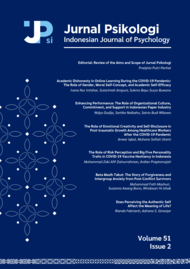Trauma Masa Anak, Hubungan Romantis, dan Kepribadian Ambang
Christin Wibhowo(1*), Klara Andromeda DS So(2)
(1) Fakultas Psikologi Universitas Gadjah Mada
(2) Fakultas Psikologi Universitas Katholik Soegijapranata Semarang
(*) Corresponding Author
Abstract
People with borderline personality features (BPF) are characterized by impulsive, emotionally unstable, have unsafe sexual activity, and other actions that are at risk to commit suicide. Although some of the behavior is not included in crime, but if there is no prevention, the BPF will endanger itself and its environment This study aims to determine the relationship of childhood trauma, a romantic relationship, with BPF. The hypothesis are, 1) there is relationship between childhood trauma and BPF;2) there is relationship between romantic relationships andBPF. This study using 77 participant wives aged 20-40 years. Collecting data using of Borderline Personality Scale, Childhood Trauma Scale and Romantic relation Scale. Data analysis with product moment.The result of this study are 1)there is a relationship between childhood trauma and borderline personality (r = 0.6, p <0.01); 2) there is relationship between romantic relationship and borderline personality (r = - 0.5= p<0.01).
Keywords
Full Text:
PDFReferences
American Psychiatric Association (APA). ( 2013). Diagnostic and statistical manual of mental disorders (DSM-5). Washington
Azwar, S. (2014). Penyusunan skala psikologi. Yogyakarta: Pustaka Pelajar.
Chan, W., McCrae, R. R., Fruyt, F. D., Lee, J., Lockenhoff, C. E., & DeBolle, M. (2012). Stereotypes of age differences in personality traits: Universal and accurate?. J Pers Soc Psychol, 103(6), 1050-1066. doi: 10.1037/a0029712.
Compton, W.C., & Hoffman, E. (2013). Positive psychology: The science of happiness and flourishing. America: Wadsworth Cengage Learning
Distel, M. (2009). Individual differences in borderline personality traits: A genetic perspective. Amsterdam: Drukkerij Van Werkhoven.
Hazan, C., & Zeifman, D. (2016). Pair bonds as attachment: Evaluating the evidence. Dalam J. Cassidy & P. Shaver (Eds.). Handbook of Attachment: Theory, research, and clinical application. New York: Guilford.
Kaehler, Laura A. & Freyd, Jennifer J. (2012). Betrayal trauma and borderline personality characteristics: Gender differences. Psychological trauma: theory, research, practice, and policy. Eugene: American Psychological Association, 4(4), 379-385.
Kernberg, O.F., & Michels, R. (2009). Borderline personality disorder. The American Journal of Psychiatry.166(5).
Keppen & Kimberly. (2014). The effects of childhood abuse on the etiology of borderline personality disorder. A research paper presented to the faculty of the Adler Graduate School.
Kitamura, T., & Nagata, T. (2014). Suicidal ideation among Japanese undergraduate students: Relationships with borderline personality trait, depressive mood, and childhood abuse experiences. American Journal of Psychology and Behavioral Sciences. Tokyo: Open Science, 1(2), 7-13.
Komnas Perempuan. (2016). Siaran pers Komnas Perempuan catatan tahunan (Catahu) 2016. Diunduh dari http://www.komnasperempuan.go.id/ siaran-pers-komnas-perempuan-catatan-tahunan-catahu-2016-7-maret-2016/
Kujipers, K., Van Der Knaap, L., Winkel, F., Pemberton, A., & Baldry, A. (2011).
Borderline traits and symptoms of post-traumatic stress in a sample of female victims of intimate partner violence. Stress and Health, 27, 206-215.
Lestari, S., Faturochman., & Kim, U. (2010). Trust in parent-child relationship among undergraduate students: Indigenous psychological analysis. Jurnal Psikologi. 37(2).
Minzenberg, M. J., Poole, J.H., & Vinogradov, S. (2008). A neurocognitive model of Borderline Personality Disorder: Effects of childhood sexual abuse and relationship to adult attachment disturbance. Development and Psychopathology. USA: Cambridge University Press. 20.
Nanu, D.E. (2015). The Attachment relationship with emotional intelligence and weel-being. Journal of Experiental Psychoteraphy, 18, 70.
Rasonabe, M.B. (2013). Predisposed borderline personality disorder (PreBPD). ISS & MLB. ISS. September 24-26, pp 1004.
Riggs, S. A. (2010). Childhood emotional abuse and the attachment system across the life cycle: What theory tell us. Journal of Aggression, Maltreatment, and Trauma, 19(1), 5-51.
Shea, T. M., & Edelen, M. O. (2010). Improvement borderline disorder in relathonship to age. Acta Psychiatri Scand. Feb. (1992),143-148.
Vermetten, E. & Spiegel, D. (2014). Trauma and dissociation: Implications for borderline personality disorder. Curr Psychiatry, 16(434), 1-10. doi: 10.1007/s11920-013-0434-8.
Watkins, C. D. (2011). Effect of maternal borderline personality disorder on romantic attachment in adolescent. Thesis. Knoxville: University of Tennessee.
Article Metrics
Refbacks
- There are currently no refbacks.
Copyright (c) 2019 Jurnal Psikologi

This work is licensed under a Creative Commons Attribution-ShareAlike 4.0 International License.
Recent Issues
 |  |  |  | ||||
| Vol 51 Issue 2 (2024) Page 120-230 | Vol 51 Issue 1 (2024) Page 1-119 | Vol 50 Issue 3 (2023) Page 219-332 | Vol 50 Issue 2 (2023) Page 125-218 |
| Published by Faculty of Psychology, Universitas Gadjah Mada, Indonesia Building D-6th, Floor No. D-606. Jl. Sosio Humaniora No. 1, Bulaksumur Yogyakarta, 55281 Email: jurnalpsikologi@ugm.ac.id Phone/whatsApp: +6281125210175 |











